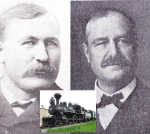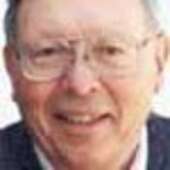Father Burlington -- the early years
Monday, January 19, 2015

Railroad Superintendent Alexander Campbell, left; builder H.P. Waite; an 1880s steam engine.
Note: Much of the following story of the McCook/Railroad connection comes from a paper delivered by long-time railroad man, H.E. (Harry) Culbertson, presented before the Southwestern Nebraska Historical Society, along with information from McCook Historian, John Cordeal, and Marion McClelland, in her book, "Early History of McCook."
The first white men to penetrate the regions west of the Mississippi were the trappers, who risked their lives to bring back furs to the eastern dandies and ladies who equated beaver pelts and furs with the highest of fashion. After the trappers, came the cattlemen, who saw opportunity in using the countless empty acres of the western plains to raise their cattle for shipment to those eastern markets. Then came the settlers, who sought to make a home, and to fence and farm those acres.
Soon, the settlers were followed by another type of adventurer. These were the railroaders, men with vision and ambition -- men who took risks, not with their lives, as had the trappers, but with their money. The settlers chose not to push very far beyond the shipping points of the railroad, their lifeline to their families in the east, and these railroaders, the men of the Burlington, planned to push their lines west, through Southwest Nebraska, to tap the region south of the Union Pacific Railroad, and turn that region into a bustling, productive population center.
The Burlington Missouri River Railroad came into Nebraska in 1879, and built its empire in Southwestern Nebraska throughout the 1880s. By 1880 the railroad had built westward, from Hastings to Indianola. Surveys, with definite line location maps were made for an extension westward to Denver, and plans called for the completion of the route to Denver in 1881.
However, 1881, was a poor time for farming and settlers. The Burlington Execs could see little advantage in any more railroad building until conditions improved. But settlers were already here, having answered the railroad's call. Postal authorities reported that there were 59 post offices in SW Nebraska, including one at Fairview, on the Republican, which would soon become McCook. Poor farming conditions had already taken its toll, and many discouraged settlers had already packed their belongings to return to their homes in the East -- Iowa or Illinois. Those remaining were hurting. They needed help.
Local Burlington officials were able to persuade the managers of the railroad to employ those settler/farmers to help build the railway west. In return the railroad got a surprisingly competent, motivated labor force to complete its line to Denver. The extra employment enabled a good many of the settlers to remain in SW Nebraska.
Officials in Omaha decreed in 1881 that it was time to build into Denver -- Construction to be completed not later than Oct. 1, 1882. The demands of this schedule were unprecedented -- to build 247 miles of standard gauge track, complete and ready to serve in just one year.
1881 turned out to be a dry year, favorable for railroad building. The settler / farmer / railroad builders learned fast.
They were pushed and encouraged by railroad President Perkins and operating Vice President Potter, and without modern labor saving devices, the crews and teams of horses and men piled up the dirt, handled the rails, and pounded the spikes. The result was that the line was built, complete and ready to serve the public by July 1, 1882. It had taken just 229 days -- a record of over one mile a day -- a remarkable achievement.
After the track layers came other railroad workers, with telegraph poles, water tanks, coaling sheds, sidings, depots, round-houses, stock-yards, and switch-yards. One worker, who became a prominent McCook business man, was H.P. Waite, a key man in the construction department of the railroad when it went through to Denver. He helped in the erection of depots, section houses and all buildings necessary to the railroads.
The first Burlington train left Denver to the east on July 1, 1882. The first consignment of freight from Chicago, consisting of 13 cars, went through McCook on July 3.
Alexander Campbell, who became a highly respected railroad official, "a great leader of men," was the first chief of the new Republican Valley Division. It was he who changed the name Fairview to McCook, in honor of his friend, Civil War Hero, Gen. Alexander McCook.
In 1880, a number of Burlington officials had formed the Lincoln Land Co., designed to buy and sell real estate, and lay out towns and villages. This company was in business for the next 23 years and provided the guiding force for the development of towns.
With the completion of the railroad to Denver the company needed to establish a division point. Arapahoe, Indianola, and Culbertson were all contenders for this honor, which would assure strong growth for that community.
Arapahoe was deemed too far east. Culbertson and Indianola were considered equally qualified, so the railroad (no doubt highly influenced by the Lincoln Land Co., which owned much property in McCook), chose to locate the division point half-way between Indianola and Culbertson, at the tiny village of Fairview, on the Republican, also half way between Lincoln, the Capital of Nebr. and Denver, the Capital of Colo.
Lots in the new town, 50' X 100', sold from $40 to $1,500. The railroad immediately began to build a red, two-story, depot, an eating house and a 25-stall round-house. Business men swarmed to McCook to build. A number of business buildings from Indianola were moved here.
By July 1, 1882 over 100 buildings, "of good quality" were being built -- three banks, two hardware stores, three groceries, three merchandise stores, one clothing store, one meat market, three hotels, three lumber yards, two drug stores, one furniture store, one shoe shop, one printing house, two real estate offices, one jewelry store--just one month after the first lots went on sale.
There were two westbound and two eastbound passenger trains, of about four cars each, per day.
The locomotives were small, with enormous smoke stacks. The cars were painted light yellow. The platforms, at each end of the car, were open. Each car was equipped with hand brakes, so set that they could be operated from the platform. Both the conductor and brakemen were needed to bring the train to a stop. There were four freights a day. Couplings were made by hand. Between the couplings and the hand operated brakes, accidents were numerous. Most editions of the McCook papers recounted accidents on the division. If a man was killed in railroad service, the engine pulling that train was draped in mourning for 30 days.
Each locomotive was assigned to a certain engineer. That man became very particular about "his engine," and was proud of its brass trim, which he kept polished. Some engineers even adorned their engines with decorations, such as a pair of antlers or a special whistle.
In May, 1884, a "super" freight train, of 22 box cars and three coaches, from Chicago to Denver stopped in McCook. The train was the first on the Burlington line to be equipped with air brakes and automatic couplers.
Mr. George Westinghouse, the inventor of the air brakes, along with many of the high ranking Burlington officials, were making the trip to see personally just how well the new safety devices would work. (They worked fine, and signaled a new era of safety, efficiency, and economics in the world of railroads.)
With the completion of the railway to Denver, the Burlington promotion to bring settlers to the area really began to pay off. In the 1870s, the railroad had opened its campaign by flooding the US, Canada, and Europe with hundreds of thousands of pamphlets, printed in a dozen languages, as well as English. 200 agents sought out prospects to bring immigrants from the East and North, and offices were opened in England and mainland Europe. Crop samples from the rich lands in eastern Nebraska showed up at agricultural shows in the east and abroad.
In Nebraska the stream of immigrants that had followed the Platte in the '70s was diverted so that by the '80s its center passed through the region bisected by the B & M Railroad.

